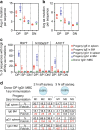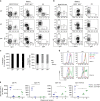IgG1 memory B cells keep the memory of IgE responses
- PMID: 28935935
- PMCID: PMC5608722
- DOI: 10.1038/s41467-017-00723-0
IgG1 memory B cells keep the memory of IgE responses
Erratum in
-
Publisher Correction: IgG1 memory B cells keep the memory of IgE responses.Nat Commun. 2018 Mar 1;9(1):968. doi: 10.1038/s41467-018-03364-z. Nat Commun. 2018. PMID: 29497073 Free PMC article.
Abstract
The unique differentiation of IgE cells suggests unconventional mechanisms of IgE memory. IgE germinal centre cells are transient, most IgE cells are plasma cells, and high affinity IgE is produced by the switching of IgG1 cells to IgE. Here we investigate the function of subsets of IgG1 memory B cells in IgE production and find that two subsets of IgG1 memory B cells, CD80+CD73+ and CD80-CD73-, contribute distinctively to the repertoires of high affinity pathogenic IgE and low affinity non-pathogenic IgE. Furthermore, repertoire analysis indicates that high affinity IgE and IgG1 plasma cells differentiate from rare CD80+CD73+ high affinity memory clones without undergoing further mutagenesis. By identifying the cellular origin of high affinity IgE and the clonal selection of high affinity memory B cells into the plasma cell fate, our findings provide fundamental insights into the pathogenesis of allergies, and on the mechanisms of antibody production in memory B cell responses.IgE is an important mediator of protective immunity as well as allergic reaction, but how high affinity IgE antibodies are produced in memory responses is not clear. Here the authors show that IgE can be generated via class-switch recombination in IgG1 memory B cells without additional somatic hypermutation.
Conflict of interest statement
The authors declare no competing financial interests.
Figures







References
-
- He JS, et al. Biology of IgE production: IgE cell differentiation and the memory of IgE responses. Curr. Top Microbiol. Immunol. 2015;388:1–19. - PubMed
Publication types
MeSH terms
Substances
Grants and funding
LinkOut - more resources
Full Text Sources
Other Literature Sources
Molecular Biology Databases
Research Materials

